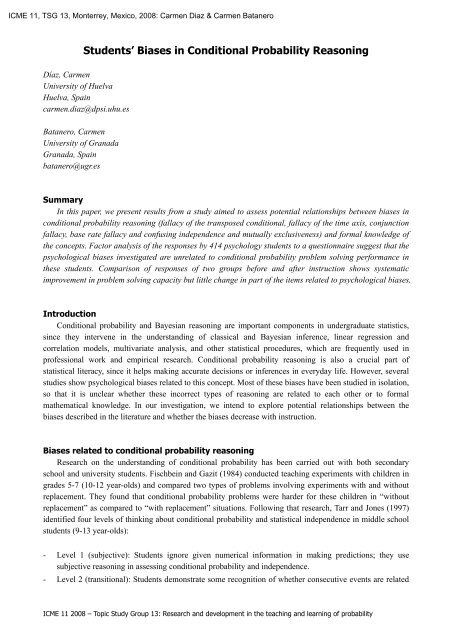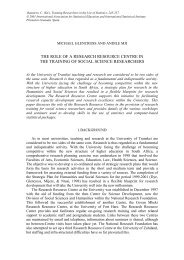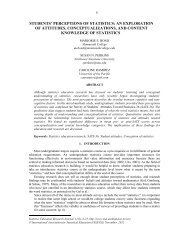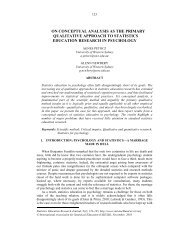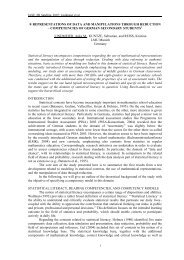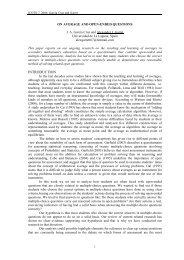Students' Biases in Conditional Probability Reasoning
Students' Biases in Conditional Probability Reasoning
Students' Biases in Conditional Probability Reasoning
You also want an ePaper? Increase the reach of your titles
YUMPU automatically turns print PDFs into web optimized ePapers that Google loves.
ICME 11, TSG 13, Monterrey, Mexico, 2008: Carmen Diaz & Carmen BataneroIt also reveals the higher relevance of the first factor to which most of the open-ended problemscontribute, <strong>in</strong> particular Bayes’ problems, total probability and compound probability problems. Solv<strong>in</strong>g anyof these problems requires at least two stages, <strong>in</strong> the first of which a conditional probability is computed,which is used <strong>in</strong> subsequent steps (e.g. product rule). We <strong>in</strong>terpret this factor as ability to solve complexconditional probability problems. Comput<strong>in</strong>g simple, jo<strong>in</strong>t and conditional probability from a two-way table(item 1) appears as a separate factor, probably because the task format affected performance, a fact which hasalso been noticed by Ojeda (1996), Gigerenzer (1994) and Lonjedo and Huerta (2005), amongst otherresearchers. A third factor reflects the relationships between def<strong>in</strong>ition, sample space and computation ofconditional probabilities <strong>in</strong> “with and without replacement” situations, which suggests that it may beidentified with Level 4 reason<strong>in</strong>g <strong>in</strong> the classification by Tarr and Jones (1997).The rema<strong>in</strong><strong>in</strong>g factors po<strong>in</strong>t out to the different biases affect<strong>in</strong>g conditional probability reason<strong>in</strong>g, whichwe describe <strong>in</strong> the <strong>in</strong>troduction, and which appear unrelated to mathematical performance <strong>in</strong> problem solv<strong>in</strong>gunderstand<strong>in</strong>g (Factor 1), comput<strong>in</strong>g probabilities from a two-way table (Factor 2), and to Tarr and Jones’s(1997) level 4 reason<strong>in</strong>g (Factor 3) as the related items are not <strong>in</strong>cluded <strong>in</strong> the first three factors. Each of thebiases (transposed conditional, time axis fallacy, conjunction fallacy, <strong>in</strong>dependence/mutually exclusiveness)also appear unrelated to one another; <strong>in</strong> some cases some of them are opposed or related to somemathematical components of understand<strong>in</strong>g conditional probability. For example, <strong>in</strong>dependence is l<strong>in</strong>ked tothe base rate fallacy problem (where people have to judge whether the events are <strong>in</strong>dependent or not) andopposed to the idea of dependence.Table 1. Factor Load<strong>in</strong>gs for Rotated Components <strong>in</strong> Factor Analysis of Responses to ItemsItemFactor1 2 3 4 5 6 718. Solv<strong>in</strong>g Bayes’ problem .7714. Solv<strong>in</strong>g total probability problem .7617. Solv<strong>in</strong>g product rule problem, <strong>in</strong> case of dependence .7616. Solv<strong>in</strong>g product rule problem, <strong>in</strong> case of <strong>in</strong>dependence .6715. Solv<strong>in</strong>g a conditional probability problem, <strong>in</strong> case of <strong>in</strong>dependence .43 .4212. Describ<strong>in</strong>g the restricted sample space .40 .462. Base rate fallacy .34 .481b. Comput<strong>in</strong>g conditional probability from a 2- way table .32 .611c. Comput<strong>in</strong>g jo<strong>in</strong>t probability, from a 2- way table .791a. Simple probability, from a 2- way table .611d. Comput<strong>in</strong>g <strong>in</strong>verse conditional probability from a 2- way table .7713. Solv<strong>in</strong>g a conditional probability problem, <strong>in</strong> a s<strong>in</strong>gle experiment .6711. Def<strong>in</strong><strong>in</strong>g conditional probability and giv<strong>in</strong>g an example .594. Solv<strong>in</strong>g a conditional probability problem, <strong>in</strong> case of dependence .39 .449b. Time axis fallacy .718. Time axis fallacy .7010. Solv<strong>in</strong>g a jo<strong>in</strong>t probability problem <strong>in</strong> diachronic experiments .35 -.465. Comput<strong>in</strong>g conditional probability from jo<strong>in</strong>t and compound probability .666. Conjunction fallacy .627. Transposed conditional /causal-diagnostic -.659a. Comput<strong>in</strong>g conditional probability, dependence .663. Independence /mutually exclusiveness .684
ICME 11, TSG 13, Monterrey, Mexico, 2008: Carmen Diaz & Carmen BataneroImprovement with <strong>in</strong>structionDiscrim<strong>in</strong>ant analysis is used to study improvement after <strong>in</strong>struction, us<strong>in</strong>g the groups (<strong>in</strong>struction or no<strong>in</strong>struction) as criterion for discrim<strong>in</strong>ation. Several statistics (Wilks’ Lambda= 0.63; Chi-Square χ 2 =171.117;canonical correlation=0.697; 82.3% students correctly classified) reveal a high discrim<strong>in</strong>ant power of theCPR questionnaire.In Table 2 we present percentages of correct responses to each item <strong>in</strong> both groups and p-values for thedifferences between the two groups. Differences always favour the group with <strong>in</strong>struction and arestatistically significant, with exception of the items assess<strong>in</strong>g the conjunction fallacy, the fallacy oftransposed conditional, understand<strong>in</strong>g of the difference between causal and diagnostic reason<strong>in</strong>g, and one ofthe items measur<strong>in</strong>g the fallacy of time axis. Note that, even if the difference is statistically significant <strong>in</strong> theother item assess<strong>in</strong>g the time axis fallacy, <strong>in</strong> fact results for that item are worse after <strong>in</strong>struction.Consequently, the CPR questionnaire may serve to discrim<strong>in</strong>ate between students with and without specific<strong>in</strong>struction <strong>in</strong> conditional probability if we exclude part of the items assess<strong>in</strong>g the psychological biases.Note that there was an important improvement <strong>in</strong> performance <strong>in</strong> all open-ended problem solv<strong>in</strong>g tasks:items 13 (Solv<strong>in</strong>g a conditional probability problem, <strong>in</strong> a s<strong>in</strong>gle experiment), item 14 (solv<strong>in</strong>g a totalprobability problem), item 15 (solv<strong>in</strong>g a conditional probability problem, <strong>in</strong> case of <strong>in</strong>dependence), item 16(solv<strong>in</strong>g a product rule problem, <strong>in</strong> case of <strong>in</strong>dependence), item 17 (solv<strong>in</strong>g a product rule problem, <strong>in</strong> caseof dependence), and item 18(solv<strong>in</strong>g a Bayer’s problem). Other items with good discrim<strong>in</strong>ation were item 1(computation of probabilities from a 2-way table), item 11 (def<strong>in</strong><strong>in</strong>g conditional probability and giv<strong>in</strong>gexamples of it) as well as two items assess<strong>in</strong>g psychological biases (item 2, base rate fallacy and item 3,dist<strong>in</strong>guish<strong>in</strong>g between <strong>in</strong>dependence and mutually exclusiveness).Table 2. Percentages of correct responses to items <strong>in</strong> students with and without <strong>in</strong>structionItemNo <strong>in</strong>struction(n=177)Instruction(n=208)p-value1b. Comput<strong>in</strong>g conditional probability from a 2- way table 67 94 0.0001c. Comput<strong>in</strong>g jo<strong>in</strong>t probability, from a 2- way table 29 63 0.0001a. Simple probability, from a 2- way table 35 69 0.0001d. Comput<strong>in</strong>g <strong>in</strong>verse conditional probability from a 2- way table 37 70 0.0002. Base rate fallacy 33 53 0.0003. Independence /mutually exclusiveness 23 41 0.0004. Solv<strong>in</strong>g a conditional probability problem, <strong>in</strong> case of dependence 77 89 0.0015. Comput<strong>in</strong>g conditional probability from jo<strong>in</strong>t and compound probability 37 48 0.0426. Conjunction fallacy 21 24 0.4657. Transposed conditional /causal-diagnostic 35 35 0.9898. Time axis fallacy 8 13 0.1429a. Comput<strong>in</strong>g conditional probability, dependence 72 81 0.0509b. Time axis fallacy 37 25 0.00910. Solv<strong>in</strong>g a jo<strong>in</strong>t probability problem <strong>in</strong> diachronic experiments 62 76 0.00211. Def<strong>in</strong><strong>in</strong>g conditional probability and giv<strong>in</strong>g an example 17 47 0.00012. Describ<strong>in</strong>g the restricted sample space 56 67 0.05013. Solv<strong>in</strong>g a conditional probability problem, <strong>in</strong> a s<strong>in</strong>gle experiment 20 33 0.00514. Solv<strong>in</strong>g total probability problem 18 55 0.00015. Solv<strong>in</strong>g a conditional probability problem, <strong>in</strong> case of <strong>in</strong>dependence 34 75 0.00016. Solv<strong>in</strong>g product rule problem, <strong>in</strong> case of <strong>in</strong>dependence 25 56 0.00017. Solv<strong>in</strong>g product rule problem, <strong>in</strong> case of dependence 24 59 0.00018. Solv<strong>in</strong>g Bayes’ problem 20 49 0.0005
ICME 11, TSG 13, Monterrey, Mexico, 2008: Carmen Diaz & Carmen BataneroConclusion and further researchOur results <strong>in</strong>dicate that students’ performance <strong>in</strong> problem solv<strong>in</strong>g ability and formal understand<strong>in</strong>g ofconditional probability improved with <strong>in</strong>struction; we observed a high percentage of correct solutions to allthe problems (<strong>in</strong>clud<strong>in</strong>g total probability and Bayes’ problems). However, some of the biases described <strong>in</strong> theliterature are widespread <strong>in</strong> these students’ th<strong>in</strong>k<strong>in</strong>g and do not improve with <strong>in</strong>struction.The results of the factor analysis reflect the complex relationship between probabilistic concepts and<strong>in</strong>tuition (Borovcnik, Bentz & Kapadia, 1991; Borovcnik & Peard, 1996): items assess<strong>in</strong>g biases <strong>in</strong>conditional probability reason<strong>in</strong>g are unrelated to those assess<strong>in</strong>g formal knowledge and are partly unrelatedto each other. These results are consistent with Batanero, Henry and Parzysz (2005) who trace an analogouslack of <strong>in</strong>tuition <strong>in</strong> the historical development of the discipl<strong>in</strong>e. Even though <strong>in</strong>dependence and conditionalprobability are <strong>in</strong>formally used from the very beg<strong>in</strong>n<strong>in</strong>g of the study of chance games, it is not before themiddle of the 18th century that these two concepts are made explicit <strong>in</strong> the mathematical theory. Furthermore,von Mises (1928, 1952) criticizes the formal modern def<strong>in</strong>ition of <strong>in</strong>dependence because as it is not <strong>in</strong>tuitiveat all. It is natural that these historical difficulties recur <strong>in</strong> the students’ learn<strong>in</strong>g of probability.Consequently, our research <strong>in</strong>dicates the need for re<strong>in</strong>forc<strong>in</strong>g the study of conditional probability <strong>in</strong>teach<strong>in</strong>g data analysis at university level. Moreover, it yields strong reasons for a change of teach<strong>in</strong>gapproaches. As suggested by Feller (1973, p. 114) “the notion of conditional probability is a basic tool ofprobability theory, and it is unfortunate that its great simplicity is somewhat obscured by a s<strong>in</strong>gularly clumsyterm<strong>in</strong>ology”. We also suggest to follow Nisbett and Ross’ recommendations (1980), accord<strong>in</strong>g to whichstudents should be “given greater motivation to attend closely to the nature of the <strong>in</strong>ferential tasks that theyperform and the quality of their performance” (p. 280) and consequently “statistics should be taught <strong>in</strong>conjunction with material on <strong>in</strong>tuitive strategies and <strong>in</strong>ferential errors” (p. 281). The items <strong>in</strong>cluded <strong>in</strong> theCPR questionnaire may serve <strong>in</strong>structors either to assess the extent of these biases among their students or tobuild up didactic situations where students are confronted with their misconceptions about conditionalprobability.ReferencesBar-Hillel, M.: 1983, The base rate fallacy controversy, <strong>in</strong> R. W. Scholz (Ed.), Decision mak<strong>in</strong>g underuncerta<strong>in</strong>ty, North Holland, Amsterdam, 39 – 61.Batanero, C., Henry, M. & Parzysz, B.: 2005, The nature of chance and probability, <strong>in</strong> G. A. Jones (Ed.),Explor<strong>in</strong>g probability <strong>in</strong> schools: Challenges for teach<strong>in</strong>g and learn<strong>in</strong>g, Spr<strong>in</strong>ger, New York, 15-37.Borovcnik, M., Bentz, H. J., & Kapadia, R.: 1991, A probabilistic perspective, <strong>in</strong> R. Kapadia & M.Borovcnik (Eds.), Chance encounters: <strong>Probability</strong> <strong>in</strong> education, Kluwer, Dordrecht, 27-73.Borovcnik, M. & Peard, R.: 1996, <strong>Probability</strong>, <strong>in</strong> A. J. Bishop, K. Clements, C. Keitel, J. Kilpatrick, & C.Laborde (Eds.), International handbook of mathematics education (Part 1), Kluwer, Dordrecht, 239-288.Díaz, C. & Batanero, C.: 2007, Una aproximación al teorema de Bayes con apoyo de Excel, <strong>in</strong> J. Sagula(Ed.), Memorias del 9º Simposio de Educación Matemática, Chivilcoy, Argent<strong>in</strong>a, CD-ROM.Díaz, C. & de la Fuente, E. I.: 2006, Assess<strong>in</strong>g psychology students’ difficulties with conditional probabilityand bayesian reason<strong>in</strong>g, <strong>in</strong> A. Rossman y B. Chance (Eds.), Proceed<strong>in</strong>gs of Seventh InternationalConference on Teach<strong>in</strong>g of Statistics, International Association for Statistical Education, Salvador de6
ICME 11, TSG 13, Monterrey, Mexico, 2008: Carmen Diaz & Carmen BataneroBahia, CD ROM.Eddy, D. M.: 1982, Probabilistic reason<strong>in</strong>g <strong>in</strong> cl<strong>in</strong>ical medic<strong>in</strong>e: Problems and opportunities, <strong>in</strong> D.Kahneman, P. Slovic & Tversky (Eds.), Judgement under uncerta<strong>in</strong>ty: Heuristics and biases, CambridgeUniversity Press, New York.Díaz, C. & de la Fuente, I.: 2007, Assess<strong>in</strong>g psychology students’ difficulties with conditional probabilityand bayesian reason<strong>in</strong>g. International Electronic Journal of Mathematics Education, 2 (2), 128-148.Falk, R.: 1986, <strong>Conditional</strong> probabilities: <strong>in</strong>sights and difficulties, <strong>in</strong> R. Davidson, & J. Swift (Eds.),Proceed<strong>in</strong>gs of the Second International Conference on Teach<strong>in</strong>g Statistics, International StatisticalInstitute, Victoria, 292–297.Falk, R.: 1989, Inference under uncerta<strong>in</strong>ty via conditional probabilities, <strong>in</strong> R. Morris (Ed.), Studies <strong>in</strong>mathematics education. Vol.7. The teach<strong>in</strong>g of statistics, UNESCO, Paris 175-184.Feller, W. :1973, Introducción a la teoría de las probabilidades y sus aplicaciones, Limusa, México.Fischbe<strong>in</strong>, E. & Gazit, A.: 1984, Does the teach<strong>in</strong>g of probability improve probabilistic <strong>in</strong>tuitions?Educational Studies <strong>in</strong> Mathematics, 15, 1-24.Gigerenzer, G.: 1994, Why the dist<strong>in</strong>ction between s<strong>in</strong>gle-event probabilities and frequencies is important forpsychology?, <strong>in</strong> G. Wright, & P. Ayton (Eds.), Subjective probability, Wiley, Chichester, 129 – 161.Gigerenzer, G. & Hoffrage, U.: 1995, How to improve Bayesian reason<strong>in</strong>g without <strong>in</strong>struction: Frequencyformats. Psychological Review, 102, 684 – 704.Gras, R. & Totohas<strong>in</strong>a, A.: 1995, Chronologie et causalité, conceptions sources d’obstacles épistémologiquesà la notion de probabilité. Recherches en Didactique des Mathématiques, 15(1), 49–95.Lonjedo, M, A. & Huerta, P.: 2005, The nature of the quantities <strong>in</strong> a conditional probability problem. Its<strong>in</strong>fluence <strong>in</strong> the problem resolution. Proceed<strong>in</strong>gs of CERME IV. On l<strong>in</strong>e: http://cerme4.crm.es/.Koehler, J. J.: 1996, The base rate fallacy reconsidered: Descriptive, normative, and methodologicalchallenges. Behavior and Bra<strong>in</strong> Sciences, 19, 1-54.Martignon, L. & Wassner, C.: 2002, Teach<strong>in</strong>g decision mak<strong>in</strong>g and statistical th<strong>in</strong>k<strong>in</strong>g with naturalfrequencies, <strong>in</strong> B. Phillips (Ed.), Proceed<strong>in</strong>gs of the Sixth International Conference on Teach<strong>in</strong>g Statistics.International Statistical Institute and International Association for Statistical Education, Cape Town,South Africa, on l<strong>in</strong>e: http://www.stat.auckland.ac.nz/~iase.Mises, R. von: 1952, <strong>Probability</strong>, statistics and truth. J. Neyman, O. Scholl, y E. Rab<strong>in</strong>ovitch, (Trans.),William Hodge and company, London. (Orig<strong>in</strong>al work published 1928).Nisbett, R., y Ross, L.: 1980, Human <strong>in</strong>ference: Strategies and shortcom<strong>in</strong>gs of social judgments, PrenticeHall, Englewood Cliffs, NJ.Ojeda, A. M.: 1996, Contextos, representaciones y la idea de probabilidad condicional, <strong>in</strong> F. Hitt (Ed.),Investigaciones en matemáticas educativas, Grupo Editorial Iberoamericano, México, 291-310.Pollatsek, A., Well, A. D., Konold, C. & Hardiman, P.: 1987, Understand<strong>in</strong>g conditional probabilities.Organization, Behavior and Human Decision Processes, 40, 255 – 269.Sánchez, E.: 1996, Dificultades en la comprensión del concepto de eventos <strong>in</strong>dependientes, <strong>in</strong> F. Hitt (Ed.),Investigaciones en Matemática Educativa, Grupo Editorial Iberoamericano, México, 389–404.Sánchez, E. & Hernández, R.: 2003, Variables de tarea en problemas asociados a la regla del producto enprobabilidad, <strong>in</strong> E. Filloy (Coord.), Matemática educativa, aspectos de la <strong>in</strong>vestigación actual, Fondo de7
ICME 11, TSG 13, Monterrey, Mexico, 2008: Carmen Diaz & Carmen BataneroCultura Económica, México, pp. 295 –313.Sedlmeier, P.: 1999, Improv<strong>in</strong>g statistical reason<strong>in</strong>g. Theoretical models and practical implications, Erlbaum,Mahwah, NJ.Tarr, J. E. & Jones, G. A.: 1997, A framework for assess<strong>in</strong>g middle school students’ th<strong>in</strong>k<strong>in</strong>g <strong>in</strong> conditionalprobability and <strong>in</strong>dependence. Mathematics Education Research Journal, 9, 39-59.Tarr, J. E. & Lann<strong>in</strong>, J. K.: 2005, How can teachers build notions of conditional probability and<strong>in</strong>dependence?, <strong>in</strong> G. A. Jones (Ed.), Explor<strong>in</strong>g probability <strong>in</strong> school: Challenges for teach<strong>in</strong>g andlearn<strong>in</strong>g, Spr<strong>in</strong>ger, New York, 216-238.Totohas<strong>in</strong>a, A.: 1992, Méthode implicative en analyse de données et application á l’analyse de conceptionsd’étudiants sur la notion de probabilité conditionnelle, Unpublished Ph.D. University of Rennes I.Truran, J. M., & Truran, K. M.: 1997, Statistical <strong>in</strong>dependence: One concept or two?, <strong>in</strong> B. Phillips (Ed.),Papers from Statistical Education Presented at Topic Group 9, ICME 8, Sw<strong>in</strong>burne University ofTechnology, Victoria, 87–100.Tversky, A. & Kahneman, D.: 1982a, Judgements of and by representativeness, <strong>in</strong> D. Kahneman, P. Slovic &A. Tversky (Eds.), Judgment under uncerta<strong>in</strong>ty: Heuristics and biases, Cambridge University Press, NewYork, 84-98.Tversky, A. & Kahneman, D.: 1982b, Evidential impact of base rates, <strong>in</strong> D. Kahneman, P. Slovic & A.Tversky (Eds.), Judgment under uncerta<strong>in</strong>ty: Heuristics and biases, Cambridge University Press, NewYork, 153-160.8
ICME 11, TSG 13, Monterrey, Mexico, 2008: Carmen Diaz & Carmen BataneroAppendix: English translation of the CPR questionnaireItem 1. (Estepa, 1994). In a medical centre a group of people were <strong>in</strong>terviewed with the follow<strong>in</strong>g results:55 years-old or younger Older than 55 TotalPrevious heart stroke 29 75 104No previous heart stroke 401 275 676Total 430 350 780Suppose we select at random a person from this group:a. What is the probability that the person had a heart stroke?b. What is the probability that the person had a heart stroke and, at the same time is older than 55?c. When the person is older than 55, what is the probability that he/she had a heart stroke?d. When the person had a heart stroke, what is the probability of be<strong>in</strong>g older than 55?Item 2. (Tversky & Kahneman, 1982a). A witness sees a crime <strong>in</strong>volv<strong>in</strong>g a taxi <strong>in</strong> a city. The witness saysthat the taxi is blue. It is known from previous research that witnesses are correct 80% of the time whenmak<strong>in</strong>g such statements. The police also know that 15% of the taxis <strong>in</strong> the city are blue, the other 85% be<strong>in</strong>ggreen. What is the probability that a blue taxi was <strong>in</strong>volved <strong>in</strong> the crime?80a. 100c.b.1510015 8015×80× d.100 10085×20 + 15×80Item 3. (Sánchez, 1996). A standard deck of play<strong>in</strong>g cards has 52 cards. There are four suits (clubs,diamonds, hearts, and spades), each of which has thirteen cards (2,..., 9, 10, Jack, Queen, K<strong>in</strong>g, Ace). Wepick a card up at random. Let A be the event “gett<strong>in</strong>g diamonds” and B the event “gett<strong>in</strong>g a Queen”. Areevents A and B <strong>in</strong>dependent?a. A and B are not <strong>in</strong>dependent, s<strong>in</strong>ce there is the Queen of diamonds.b. A and B are only then <strong>in</strong>dependent when we first get a card to see if it is a diamond, return the cardto the pack and then get a second card to see if it is a Queen.c. A and B are <strong>in</strong>dependent, s<strong>in</strong>ce P(Queen of diamonds)= P(Queen) × P(diamonds).d. They A and B are not <strong>in</strong>dependent, s<strong>in</strong>ce P(Queen | diamonds) ≠ P(Queen).Item 4. There are four lamps <strong>in</strong> a box, two of which are defective. We pick up two lamps at random from thebox, one after the other, without replacement. Given that the first lamp is defective, which answer is true?a. The second lamp is more likely to be defective.b. The second lamp is most likely to be correct.c. The probabilities for the second lamp be<strong>in</strong>g either correct or defective are the same.9
ICME 11, TSG 13, Monterrey, Mexico, 2008: Carmen Diaz & Carmen BataneroItem 5. (Eddy 1982). 10.3 % of women <strong>in</strong> a given city have a positive mammogram. The probability that awoman <strong>in</strong> this city has both positive mammogram and a breast cancer is 0.8%. A mammogram given to awoman taken at random <strong>in</strong> this population was positive. What is the probability that she actually has breastcancer?a. 0.8 = 0.0776 , 7.76 %b. 10.3 × 0.8 = 8.24 , 8.24 %c. 0.8 %10.3Item 6. (Tversky & Kahneman, 1982 b). Suppose a tennis player reaches the Roland Garros f<strong>in</strong>al <strong>in</strong> 2005.He has to w<strong>in</strong> 3 out of 5 sets to w<strong>in</strong> the f<strong>in</strong>al. Which of the follow<strong>in</strong>g events is more likely or are they allequally likely?a. The player will w<strong>in</strong> the first set.b. The player will w<strong>in</strong> the first set but lose the match.c. Both events a. and b. are equally likely.Item 7. (Pollatsek et al. 1987). A cancer test is adm<strong>in</strong>istered to all the residents <strong>in</strong> a large city. A positiveresult is <strong>in</strong>dicative of cancer and a negative result of no cancer. Which of the follow<strong>in</strong>g results is more likelyor are they all equally likely?a. A person has cancer if they get a positive result.b. To have a positive test if the person has cancer.c. The two events are equally likely.Item 8. (Ojeda 1996).We throw a ball <strong>in</strong>to the entrance E of amach<strong>in</strong>e (see the figure). If the ball leaves the system through exit R,what is the probability that it passed by channel I?a.1 1b.23c.23d. Cannot be computedItem 9. (Falk, 1986, 1989). Two black and two white marbles are put <strong>in</strong> an urn. We pick a white marble fromthe urn. Then, without putt<strong>in</strong>g the white marble <strong>in</strong>to the urn aga<strong>in</strong>, we pick a second marble at random fromthe urn.If the first marble is white, what is the probability that this second marble is white? (W | W )P 2 1a.1 1 1b.26c. 3d.14If the second marble is white, what is the probability that the first marble is white? (W | W )a. 31b. Cannot becomputedc.P 1 21d.61210
ICME 11, TSG 13, Monterrey, Mexico, 2008: Carmen Diaz & Carmen BataneroItem 10. An urn conta<strong>in</strong>s one blue and two red marbles. We pick up two marbles at random, one after theother without replacement. Which of the events below is more likely or are they equally likely?a. Gett<strong>in</strong>g two red marbles.b. The first marble is red and the second is bluec. The two events a) and b) are equally likely.Item 11. Expla<strong>in</strong> <strong>in</strong> your own words what a simple and a conditional probability is and provide an example.Item 12. Complete the sample space <strong>in</strong> the follow<strong>in</strong>g random experiments:a) Observ<strong>in</strong>g gender (male/female) of the children <strong>in</strong> a three children family (e.g. M F M ,...)b) Observ<strong>in</strong>g gender of the children <strong>in</strong> a three children family if two or more children are male.Item 13. In throw<strong>in</strong>g two dice the product of the two numbers is 12.What is the probability that none of the two numbers is a six (we take the order of the numbers <strong>in</strong>to account).Item 14. 60% of the population <strong>in</strong> a city are men and 40% women. 50% of the men and 35% of the womensmoke. We select a person from the city at random; what is the probability that this person is a smoker?Item 15. A person throws a die and writes down the result (odd or even). It is a fair die (that is, all thenumbers are equally likely). These are the results after 15 throws:Odd, even, even, odd, odd, even, odd, odd, odd, odd, even, even, odd, odd, odd.The person throws once more. What is the probability to get an odd number this time?Item 16. A group of students <strong>in</strong> a school take a test <strong>in</strong> mathematics and one <strong>in</strong> English. 80% of the studentspass the mathematics test and 70% of the students pass the English test. Assum<strong>in</strong>g the two subjects score<strong>in</strong>dependently, what is the probability that a student passes both tests (mathematics and English)?Item 17. Accord<strong>in</strong>g to a recent survey, 91% of the population <strong>in</strong> a city usually lie and 36% of those usuallylie about important matters. If we pick a person at random from this city, what is the probability that theperson usually lies about important matters?Item 18. (Totohas<strong>in</strong>a 1982). Two mach<strong>in</strong>es M 1 and M 2 produce balls. Mach<strong>in</strong>e M 1 produces 40 % and M 260% of balls. 5% of the balls produced by M 1 and 1% of those produced by M 2 are defective. We take a ballat random and it is defective. What is the probability that that ball was produced by mach<strong>in</strong>e M 1 ?11


